
Why is Andy Warhol’s Details of Renaissance Paintings series capturing the art world’s attention right now? Long admired by experienced collectors, these four portfolios are now commanding a broader spotlight. What insights have these connoisseurs discerned that are now becoming apparent to a wider audience? At a recent auction at Phillips in London, four trial proofs from this series not only surpassed high estimates but also set new auction records. This surge in market value signals a growing demand, and positions Warhol’s Renaissance series as a dark horse in the art market; a compelling bet for collectors and art enthusiasts alike. This is why we decided, in our February newsletter, to explore the visual impact and the cultural significance of these reimagined classics.
Crafted in 1984, Warhol’s Details of Renaissance Paintings is a striking homage to the fame, beauty and grandeur of Renaissance art. By selecting iconic paintings from the Renaissance period and magnifying specific features, Warhol isolates them from their traditional historical narrative to re-envision them through the lens of Pop culture. This act of recontextualization transforms these classical images into contemporary celebrities and scenes of the art world.
Warhol’s continuous engagement with Renaissance artworks throughout his career, including his early works based on Da Vinci’s Mona Lisa and his later works on The Last Supper, which serve as significant bookends to the Details of Renaissance Paintings series. The irony of Warhol, known for his Campbell’s Soup Cans and portraits of Hollywood celebrities, embracing the traditionally exalted Renaissance masterpieces, speaks volumes about his artistic journey and the evolving perceptions of art. However, Warhol’s print series from 1984 is very distinct from the paintings he produced at the beginning and the end of his career. Notably, the shift in focus–from presenting iconic Renaissance artworks in their entirety, to cropped, less recognizable elements–reflects a deeper exploration into the essence of these artworks beyond their iconic status.
Join us as we delve into the significance of these works, and uncover the layers of Warhol’s artistic vision. His approach to recontextualizing Renaissance art offers a window into his exploration of fame, beauty, and the sacred, mirroring the evolution of societal values from the Renaissance era to the present day. Understanding the unique blend of historical reverence and contemporary critique in Warhol’s series reveals their true significance, enhancing their allure and desirability in the modern art landscape.
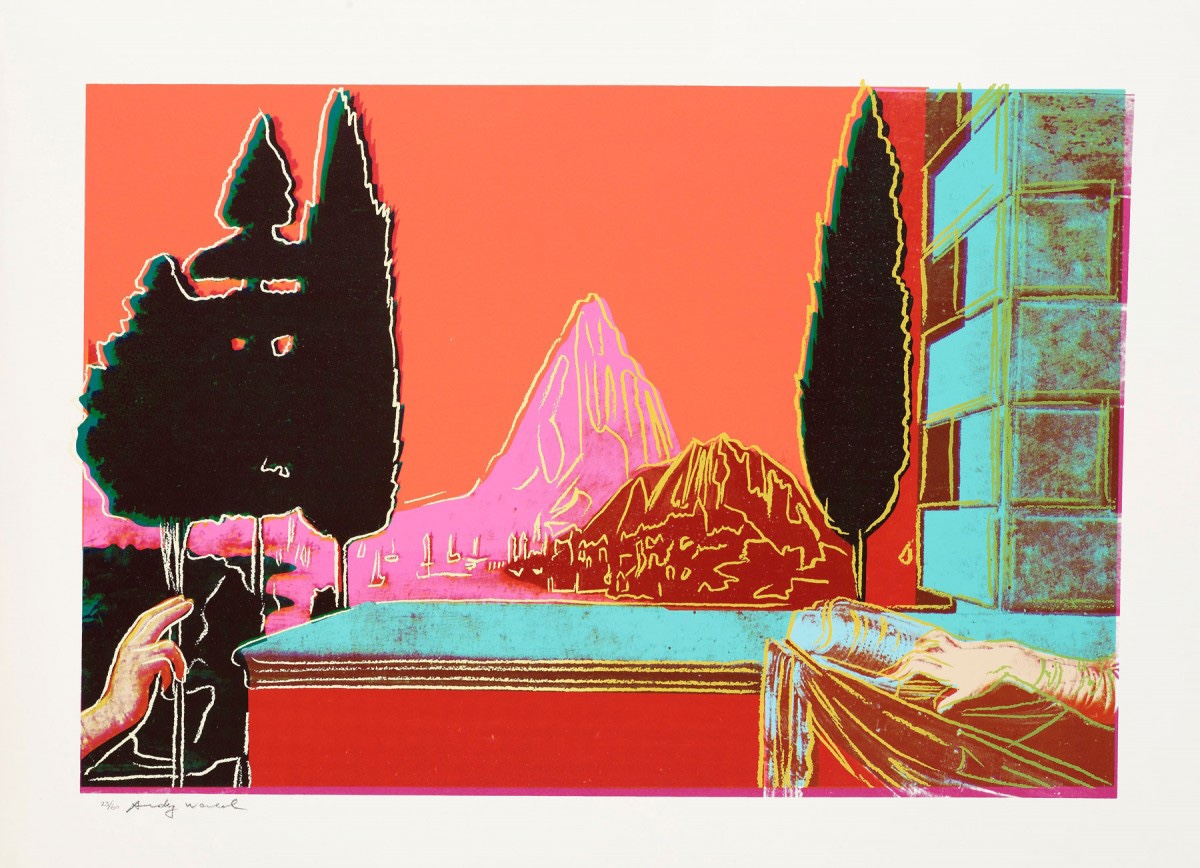
Re-Imagining the Past: Warhol's Lens on the Renaissance
The creation of Warhol’s Details of Renaissance Paintings series in 1984 was as much a collaborative endeavor as it was a testament to Warhol’s ability to bridge historical reverence with contemporary art. Initially conceptualized by the art dealer Bernd Klüser and publisher Jörg Schellmann, this series was born out of a desire to suggest new subject matter to Warhol, who had been predominantly working on commissions.
Warhol’s engagement with the project was characteristically understated yet impactful. Upon being presented with the idea and a few experimental details by Klüser and Schellmann, including the suggestion that the head of Venus by Botticelli was reminiscent of a Hollywood starlet, Warhol’s response was simple yet telling. He asked, “can’t you find more famous paintings?”
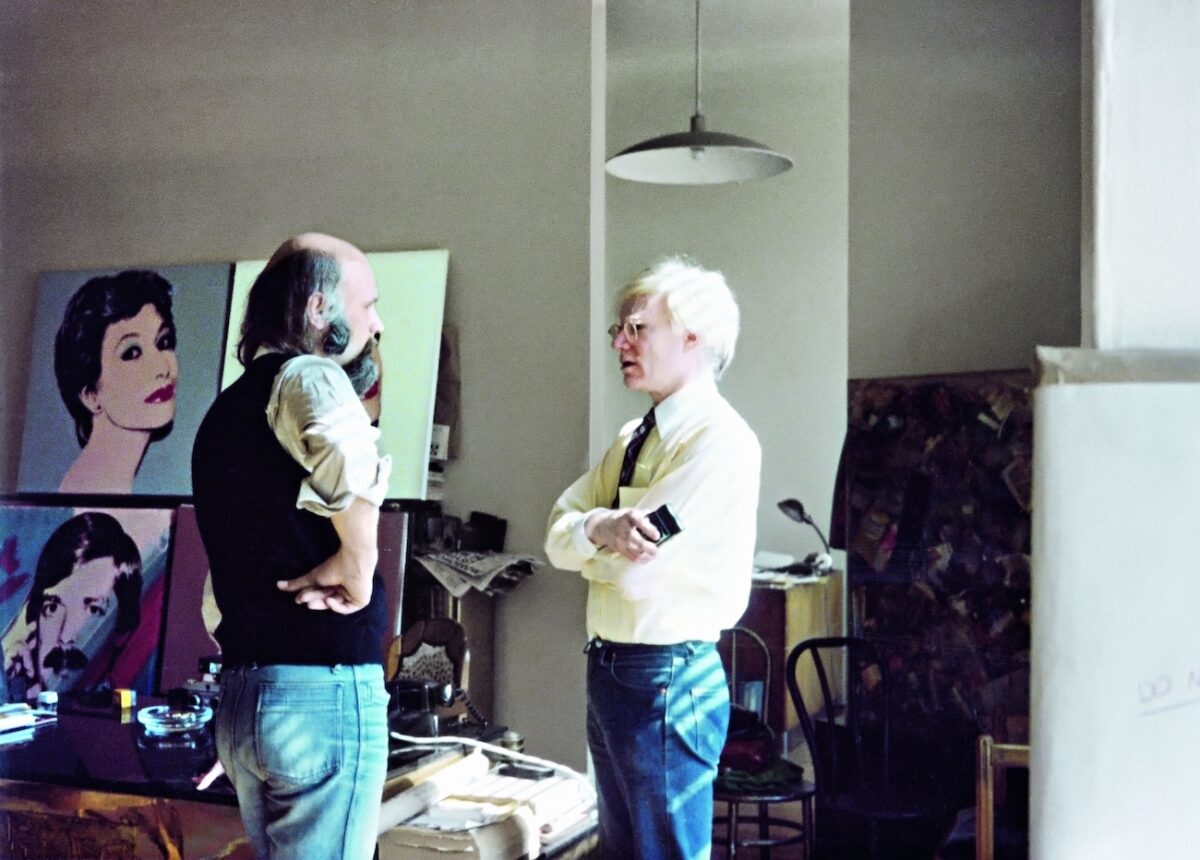
This seemingly vapid utterance requires a bit of context: Warhol’s initial interest in Renaissance art was related to how it had seeped into the fabric of popular culture.
In 1963, Warhol recognized the Mona Lisa’s rare transatlantic journey from Paris to the U.S. for exhibitions in Washington and New York as a critical moment that highlighted the intersection of historical art with modern celebrity. Captivated by this fusion, Warhol’s fascination with the concept of fame and the commodification of iconic images informed his early work with Renaissance art. That year he produced his Colored Mona Lisa painting; a vibrant creation where Da Vinci’s La Gioconda is replicated multiple times across the canvas in vivid pop colors. The artwork not only showcases the entire painting but also zooms in on iconic details like the face and hands, encapsulating Warhol’s unique fusion of classical artistry and modern pop culture.
Fast forward to 1987, and Warhol’s exhibition Il Cenacolo featured his interpretations of Da Vinci’s The Last Supper. Staged in Milan’s Palazzo delle Stelline, just a stone’s throw from the original masterpiece, this exhibition marked a poignant moment in Warhol’s career. By then, Warhol had established himself as an icon, paralleling the Renaissance masters he reimagined and admired. His Last Supper works, displayed in their entirety, reproduced multiple times, or cropped to highlight universally recognized details, resonated with iconic glory, bridging centuries of artistic expression.

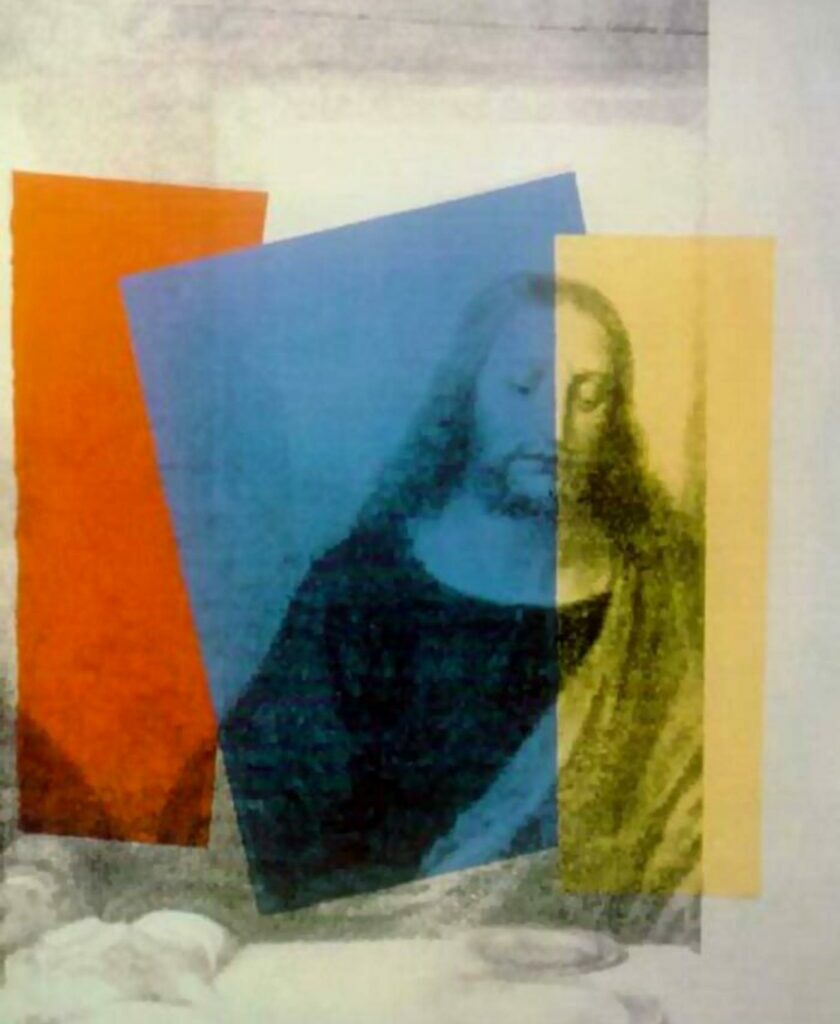
In stark contrast, the Details of Renaissance Paintings series deliberately crops and isolates elements from these classical masterpieces to render them almost unrecognizable. This method of focusing on specific, less familiar details signifies a deeper inquiry into the essence of these artworks, moving beyond the established iconic status that the art world attributed to them.
Moreover, the Details portfolios, produced as editions of screenprints on paper, diverges from the unique, exhibition-focused nature of his early and late works. This choice democratizes art, aligning with Warhol’s philosophy of making art more accessible. Unlike the one-off paintings destined for high-profile exhibitions and affluent collectors, these screenprints were more attainable, broadening the scope of who could own a piece of Warhol’s interpretation of the Renaissance.
The actual process of creating the Details of Renaissance Paintings series involved a collaborative effort between Warhol and his printer, Rupert Jasen Smith. Warhol traced the outline images projected onto paper, while Rupert produced halftone images. This collaborative process resulted in a series of proofs from which the final selections were made. Even Warhol’s contribution to the selection process was minimal yet important, often based on his preference for certain colors, such as his liking for the blue version of Venus. Yet, beyond the selection that went into the regular edition portfolios for each work, time had the effect of transforming the trial proofs that had been set apart into unique and highly desirable works of art. As Schellmann reflects:
When looking at the portfolio and the proofs in retrospect, so many of the proofs seem to be more attractive than the images we had selected for the regular editions at the time. How could that be? Perhaps it was because after about thirty years, the images are finally ready for their own renaissance. The Rebirth of Venus, as it were. (Jörg Schellmann (ed.), Andy Warhol Unique, Munich/New York, 2014, p. 99)
The Rebirth of Venus, indeed! Warhol’s Details of Renaissance Paintings series, with its innovative blend of Renaissance grandeur and Pop art sensibility, now finds itself at a pivotal moment in its reception. Over the years, what were once considered mere proofs, set aside by the artist and his collaborators, have matured into unique and sought-after pieces. Their growing value and appeal reflect the art world’s shifting perceptions and tastes, where time often reshapes the significance and desirability of an artwork. The current surge in interest and value highlights the series’ enduring appeal and underscores its ability to resonate with contemporary audiences. But what exactly fuels this resonance today? Let’s look into some of the factors that make Warhol’s reinterpretations especially relevant in our current cultural landscape.
“The Rebirth of Venus”: Warhol’s Renaissance Art and Modern Perception
Warhol’s reinterpretation of these Renaissance works invites viewers to reconsider familiar masterpieces in a rapidly evolving cultural landscape. By focusing on particular elements of the original masterpieces, the resulting artworks suggest that their grandeur is multifaceted and subjective. Each piece in the series is rendered with a distinct color palette and line work, emphasizing a remarkable range in the artistic interpretation of the detail. And in true Warhol fashion, he presents the subjects independently, devoid of their original context, echoing the way modern celebrities or consumer goods are often perceived.
Warhol’s selective focus and vibrant colors not only create a psychological impact that extends beyond the visual but also align with contemporary understandings of identity as fragmented and multifaceted. This approach encourages a deeper, more contemplative engagement with art, moving beyond superficial appreciation, aligning more with ideas of mindfulness and distraction associated with our modern, media-saturated age. Art, in this context, must compete for our focus in unique and captivating ways, a challenge Warhol navigates masterfully.
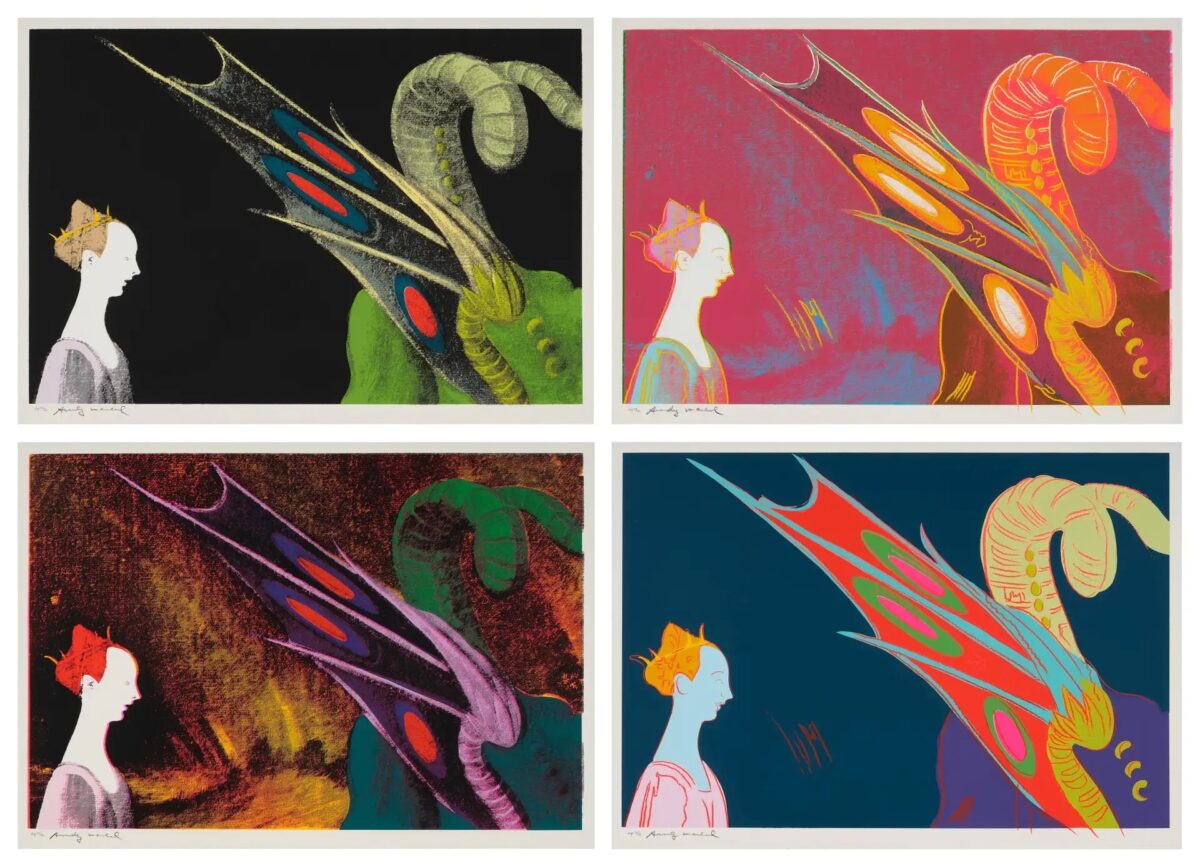
Take Warhol’s Paolo Uccello, St. George and the Dragon, for example. The selective cropping shifts the narrative from St. George’s valor towards a more ambiguous interaction between the damsel and the dragon, inviting viewers to interpret the scene without the lens of religious triumph. The damsel is presented in profile, her expression contemplative, as she gazes upon the dragon’s hindquarters and wing. The use of vibrant, almost neon colors, contrasts sharply with the muted, earthy tones of the Renaissance palette, bringing a contemporary edge to the medieval legend. The dragon’s wing and the damsel’s figure ‘pop’ against the backdrop, not only updating the artwork but also commenting on the nature of storytelling and representation.
Similarly, The Annunciation radically crops Da Vinci’s original painting, transforming a biblical scene into a serene landscape dominated by graphic quality and infused with Warhol’s iconic Pop colors. This reinterpretation suggests a modern indifference to the sacred, focusing on aesthetic rather than spiritual elements, reflecting contemporary society’s shifting values and perceptions.
In Madonna Del Duca, Warhol distills Piero della Francesca’s Brera Madonna to its architectural essence, transforming the sacred conversation into a study of form and symbolism. The focus on the dome and the ostrich egg, set against Warhol’s vivid color palette, creates a dialogue between creation and structure, inviting viewers to engage with the artwork in a more introspective manner.
Highly coveted and most recognizable in this series is the Birth of Venus artworks, where the iconic figure is reimagined with a vibrant, contemporary twist. This striking screenprint transforms Sandro Botticelli’s Renaissance masterpiece into a symbol of modern Pop culture, elevating Venus to the status of a pop celebrity. Warhol’s focus on Venus’s face and flowing hair accentuates her features in a distinctly commercialized manner, reminiscent of modern advertising aesthetics. The unique color schemes and line work in each portrait in the series alter Venus’s expression, adding layers of modern interpretation to the classical image.
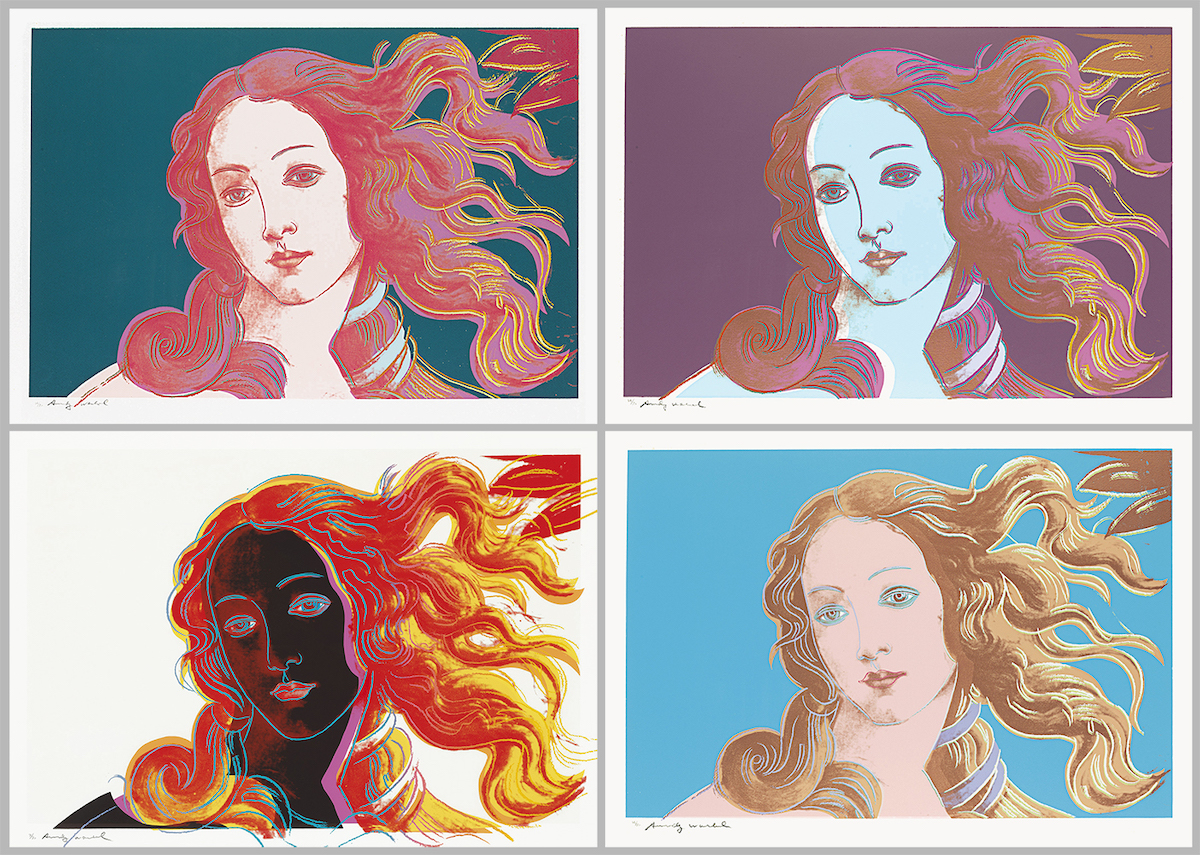
The cropping of Venus in Warhol’s work is particularly noteworthy. By isolating the mythical goddess’ face and hair, Warhol draws a parallel between Venus and another iconic figure of beauty and fame: Marilyn Monroe. This comparison is evoked through Warhol’s famous transformation of a publicity photo by Gene Korman into a Pop Art icon for his Marilyn Monroe artworks. In Birth of Venus, this technique serves to highlight the timeless fascination with beauty, desire, and fame, linking two distinct eras and their respective ideals while highlighting the timeless fascination with beauty, desire, and fame.
All of the artworks in this series are rendered in a multitude of colors and unique trial proofs that hint at unlimited possible combinations. By recontextualizing these works in the realm of Pop Art, Warhol not only pays homage to the masterpieces but also invites a modern audience to engage with Renaissance art in a new and dynamic way. More than just a visual spectacle, these pieces form a conceptual statement that resonates profoundly with contemporary audiences. By recontextualizing these Renaissance works, Warhol invites viewers to reconsider familiar masterpieces in a rapidly evolving cultural landscape, bridging historical reverence with contemporary artistic sensibilities.
Rising Stars: The Market Surge of Warhol's Renaissance Works
This evolving perception and increasing appreciation of Warhol’s Details of Renaissance Paintings series is mirrored in the art market of 2024, which is currently witnessing a remarkable surge in interest and value for these works. Previously under the radar, they are now gaining traction and are expected to see a significant increase in value. This shift is particularly satisfying for collectors and investors who have been tracking these series for years, recognizing their potential. With its blend of Warhol’s iconic pop art style and homage to Renaissance masterpieces, this series is proving to be a wise investment choice, offering both artistic merit and financial promise.
Recent sales from the first month of 2024 have showcased the burgeoning demand for Warhol’s Renaissance works, but the rare-to-the-market Trial Proofs (TP) from his Renaissance series are being bought for particularly high numbers.
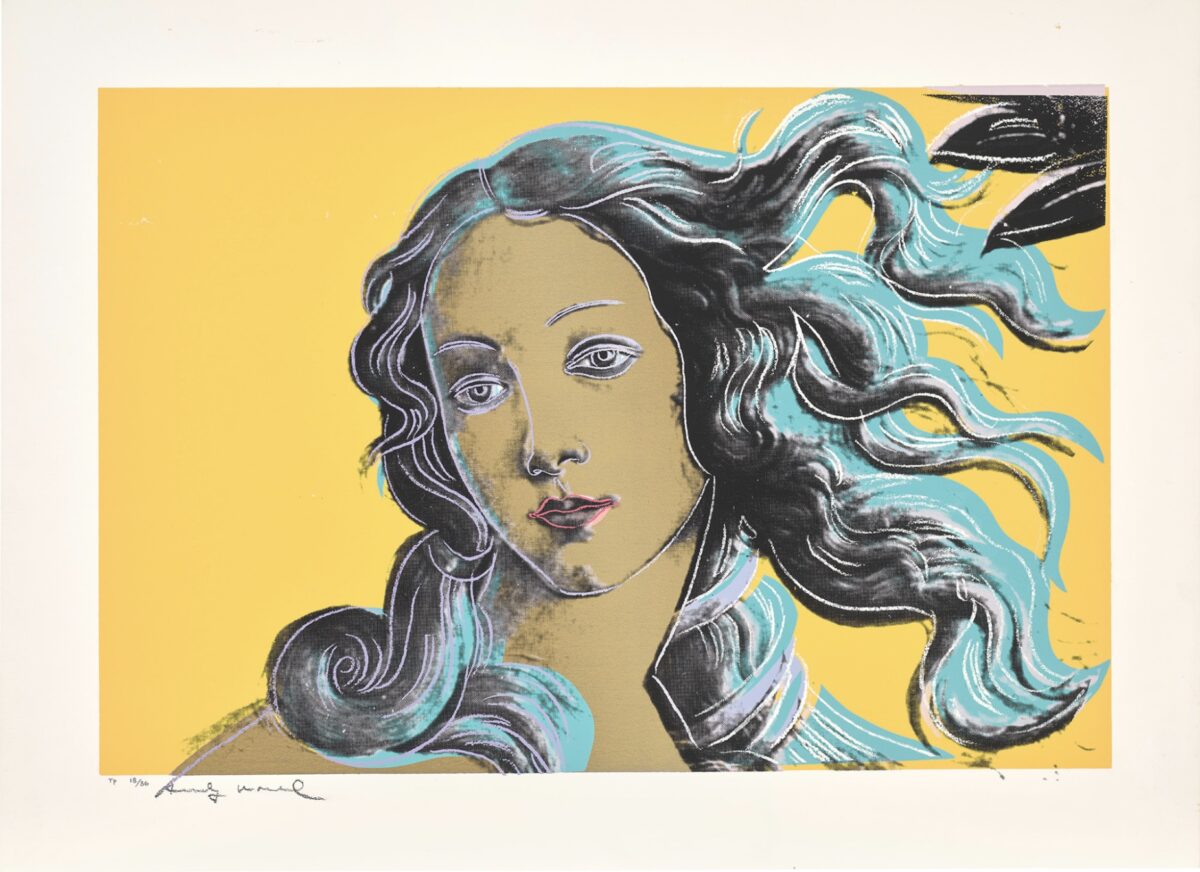
The standout piece in the series, ‘Details of Renaissance Paintings (Sandro Botticelli, Birth of Venus, 1482) (F. & S. II.316-319) (TP),’ achieved a remarkable result at the auction. It fetched a hammer price of approximately $297,310 USD, soaring to 1.5 times its high estimate. This impressive performance not only underscored the series’ robust investment potential but also came close to setting a new auction record for the piece. In addition, two other works from the same series set new auction records: The Annunciation (TP) sold for about $67,497, exceeding its high estimate by 1.2 times. A St. George and the Dragon Trial Proof went for approximrately $51,427 USD, surpassing its high estimate by a notable 2.6 times. Additionally, Madonna del Duca da Montefeltro, circa 1472) achieved about $38,570 USD, matching its previous auction record and reaching 1.6 times its high estimate. These numbers show that, if you’re fortunate enough to own a piece of Warhol’s Renaissance artworks, it might be a good time to sell your Warhol.
These commendable sale results (as well as the visual intrigue and low edition number of the works) firmly position Warhol’s Details of Renaissance Paintings as a series to watch in 2024. They also mark a significant shift in market trends that leans towards the unexpected. While Warhol’s renowned trophy prints, such as Queen Elizabeth II and Mick Jagger, continue to perform admirably, they are now aligning with market expectations rather than exceeding them. For instance, the Queen Elizabeth II Royal Edition artworks, as well as the Mick Jagger suites, have achieved impressive sales figures lately, yet they falls short of peak auction records.
This trend, bolstered by the impressive performance of the Endangered Species portfolio in recent years, highlights the growing intrigue and investment potential of Warhol’s lesser-known series and portfolios. The artworks that comprise Details of Renaissance Paintings, which have long been on the radar of discerning collectors and investors, are now emerging as unexpected frontrunners in the art market. Their recent success at auction is a validation of the foresight shown by those who have been closely monitoring and investing in these series over the years.
Our previous Warhol Print Market reports had highlighted the promising future of prints like Mick Jagger and Queen Elizabeth II, predictions that have been borne out in their consistent market performance. As the Details of Renaissance Paintings series begin to capture the market’s attention and exceed expectations, they affirm our long-held belief in their potential for significant appreciation in value. Offering both artistic merit and financial promise, these works may be poised to become the next highlight in Warhol’s illustrious legacy, making them a compelling addition to any art collection. As we continue to track their trajectory in 2024, the growing market interest in this series not only underscores their financial value, but also highlights the profound impact of Renaissance art on contemporary cultural discourse at a critical time.
Warhol's Renaissance in the Modern Era: Art, Activism, and Social Commentary
The resonance of Warhol’s Details of Renaissance Paintings series extends far beyond its monetary value, reflecting deep societal currents and attitudes. Warhol’s work often comments on societal values and norms, and this series is no exception. Its focus on fame, beauty, and the sacred can be seen as a reflection of contemporary society’s values and how they have evolved since the Renaissance era. In this light, Warhol’s reimagining of these artworks in a contemporary context takes on a dual role: it not only elevates their status in the art market but also serves to protect and immortalize them, ensuring their continued relevance and discussion in the art world.
As we delved into what this series means today, its relevance beyond mere art appreciation becomes increasingly clear. On January 28th, two protesters had sprayed the Mona Lisa with pumpkin soup in a plea for the right to “healthy and sustainable food.” The choice of soup, albeit not Campbell’s, strikes one with ironic resonance. This incident, while starkly contrasting with Warhol’s reverent approach to Renaissance art, underscores a valid and pressing concern with the rise of art vandalism.
In recent times, the art world has witnessed a surge in environmental activism targeting iconic artworks. These acts, ranging from gluing hands to Botticelli’s “Spring” to throwing soup at Van Gogh’s “Sunflowers,” have ignited significant debates. These discussions encompass a range of topics, including art preservation and security, the role of art in public spaces, and the effectiveness and ethics of using art as a vehicle for protest. While we don’t endorse the methods of these activists, we acknowledge the urgency of the environmental and social issues they stand for. In contrast, Warhol’s approach opens up a different, yet profoundly impactful, conversation through art, showing that art, whether in homage or protest, continues to be a potent medium for societal reflection and change.
This emerging trend of art vandalism, set against the backdrop of Andy Warhol’s ‘Details of Renaissance Paintings’ series, creates an intriguing juxtaposition between past and present, underscoring the dynamic role of art in societal discourse. The irony is palpable – acts of vandalism challenging artworks that have endured through time, contrasted with Warhol’s series which reverently pays homage to these very pieces. This dichotomy gains further depth considering the generational shift driving these protests, predominantly led by Generation Z. This cohort, more interconnected and environmentally conscious than ever, echoes the sentiments of the youth in 1968 – Warhol’s era – when a generation rose against societal injustices, and the air was thick with revolutionary zeal. Generation Z is poised to inherit not only the environmental and social challenges they seek to address but also the legacy of art that has been preserved over centuries.
Art can serve as a potent medium for social and environmental commentary, and Warhol’s oeuvre has been known to do so. His ‘Endangered Species’ portfolio is a prime example, showcasing his commitment to environmental and social causes through a subversive yet constructive artistic lens. Warhol fondly referred to these brightly colored as his “animals in makeup,” yet they encouraged contemplation and appreciation, not only of the artworks but of the precarious situation of the animals depicted.
While this approach stands in stark contrast to the more destructive tactics employed by recent activists, the crux lies in garnering public attention. By the time Warhol was creating his ‘Endangered Species’ portfolio, he had already established himself as an art world luminary with a significant platform. In today’s media-saturated world, many important causes struggle to gain similar visibility. This raises critical questions: Does Warhol’s work continue to resonate amid these evolving dynamics? Can art still be an effective conduit for pressing social and environmental issues, or do more radical actions, which challenge the public’s reverence for historical artworks, better underscore their urgency?
Although we may not fully resolve these debates here, we can explore a point of convergence between Warhol’s treatment of Old Masters and the actions of art vandalizing protesters. Warhol’s pop culture reinterpretation of Renaissance art challenges conventional ideas of authenticity and sanctity in art. In a way akin to Walter Benjamin’s discourse on the ‘aura’ of art in the age of mechanical reproduction, Warhol’s work can be seen as both preserving and commenting on the evolving significance of art in the modern world. This notion is likely familiar to protesters, particularly those educated in the humanities or communications, where Benjamin’s theories are often taught, with the Mona Lisa frequently cited as a quintessential example. Both Warhol and these protesters appreciate the significance of encountering art-historical objects in person, amidst a world awash with reproductions. Warhol would rather have more of these copies than the originals; however, through his lens, these venerable artworks are both preserved and reinvigorated. By recontextualizing these masterpieces, his Pop Art approach acts as a form of protection, ensuring their continued relevance and engagement in contemporary discourse, a poignant consideration in light of the recent spate of vandalism against Renaissance art.
Conclusion: A Renaissance Reimagined for Today
As our exploration of Andy Warhol’s Details of Renaissance Paintings series draws to a close, we find ourselves at the intersection of art’s past and present, where traditional reverence meets contemporary interpretation. Warhol’s reimagining of these Renaissance masterpieces not only highlights his unique ability to infuse historical art with modernity but also reflects the evolving dynamics of the art world itself.
In a time where the art market is witnessing a resurgence of interest in less prominent works, Warhol’s series stands out, commanding both the gaze and the investment of seasoned collectors and new enthusiasts alike. The recent auction success of these pieces at Phillips in London is a telling indicator of their rising prominence and desirability, a testament to Warhol’s lasting impact on both art and culture.
Beyond their market appeal, these works engage deeply with current cultural dialogues, resonating with audiences today just as powerfully as in Warhol’s time. They serve as a lens through which we view the shifting landscape of societal values, from the Renaissance to the present, bridging the gap between art history and contemporary discussions on environmentalism, social activism, and the preservation of cultural heritage.
In this series, Warhol’s reinterpretations challenge us to reconsider what is sacred in art. By recontextualizing these iconic images, he not only preserves their aura but also invites us to engage with them in new, thought-provoking ways. This series is not just a reflection of Warhol’s artistic journey; it’s a mirror held up to our society, asking us to contemplate the role of art in a rapidly changing world.

